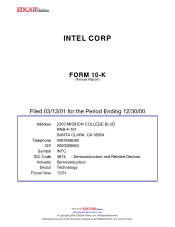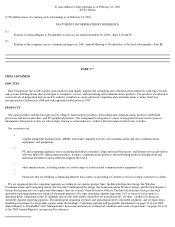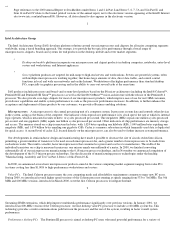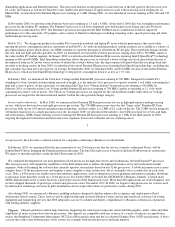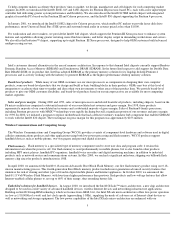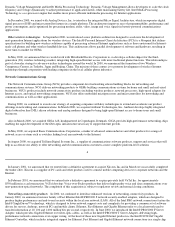Intel 2000 Annual Report Download - page 10
Download and view the complete annual report
Please find page 10 of the 2000 Intel annual report below. You can navigate through the pages in the report by either clicking on the pages listed below, or by using the keyword search tool below to find specific information within the annual report.
2002.
During the first quarter of 2000, we purchased a fabrication facility in Colorado. During 2000, we made substantial retrofitting changes and
process improvements at this facility, including equipment installations to manufacture flash memory. We expect to begin manufacturing at the
Colorado facility in the second quarter of 2001.
We also manufacture microprocessor- and networking-related board-level products and systems at facilities in Malaysia, Oregon and
Washington. In addition, we manufacture board-level products in Puerto Rico; however, in January 2001, we announced that we would phase
out our manufacturing operations in Puerto Rico during the first half of 2001. Based on an assessment across our worldwide board-level
manufacturing facilities, we concluded that the operations in Puerto Rico were less cost competitive than our other operations.
A substantial majority of our components assembly and testing, including assembly and testing for microprocessors, is performed at facilities
in Costa Rica, Malaysia and the Philippines. We also perform components assembly and testing at a facility in China, and in August 2000
announced plans to expand this facility.
To augment capacity in the United States as well as internationally, we use subcontractors to perform assembly of certain products and wafer
fabrication for certain components, primarily flash memory, chipsets, and networking and communications component products. We also use
subcontractors for the manufacture of some board-level products and systems, and purchase certain communication networking products and
PC peripherals from external vendors.
In general, if we were unable to manufacture wafers or to assemble and test our products abroad, or if air transportation between our foreign
facilities and the United States were disrupted, there could be a material adverse effect upon our operations. In addition to normal
manufacturing, assembly and test risks, our operations outside the United States are subject to certain additional exposures, including currency
controls and fluctuations; tariff, import and other restrictions and regulations; and
10
political instability, such as unrest in Israel. To date, we have not experienced significant difficulties related to these foreign business risks.
Manufacturing of integrated circuits is a complex process. Normal manufacturing risks include errors and interruptions in the production
process and defects in raw materials, as well as other risks, all of which can affect yields. A substantial decrease in yields would result in higher
manufacturing costs and the possibility of not being able to produce sufficient volume to meet specific product demand.
EMPLOYEES
As of December 30, 2000, we employed approximately 86,100 people worldwide.
SALES
Most of our products are sold or licensed through sales offices located near major concentrations of users throughout North America,
Europe, Asia-Pacific, Japan and other parts of the world.
We also use industrial and retail distributors and representatives to distribute our products both within and outside the United States.
Typically, distributors handle a wide variety of products, including those that compete with our products, and fill orders for many customers.
Most of our sales to distributors are made under agreements allowing for price protection on unsold merchandise and right of return on
stipulated quantities of unsold merchandise. Sales representatives generally do not offer directly competitive products but may carry
complementary items manufactured by others. Representatives do not maintain a product inventory; instead, their customers place orders
directly with us or through distributors. We conducted business with more than 2,500 customers worldwide in 2000, including customers of our
acquired companies. Compaq Computer Corporation and Dell Computer Corporation each contributed approximately 13% to our total sales in
2000. A substantial majority of the sales to these two customers consisted of Intel Architecture Group products. No other customer accounted
for more than 10% of our total revenues. Sales to our five largest customers accounted for approximately 42% of total revenues. The
information regarding revenues and operating profit by reportable segments and revenues from unaffiliated customers by geographic region
under the heading "Operating segment and geographic information" on page 33 of our 2000 Annual Report to Stockholders, is incorporated by
reference.
BACKLOG
Our sales are made primarily pursuant to standard purchase orders for delivery of standard products. We have some agreements that give a
customer the right to purchase a specific number of products during a specified time period. Although not generally obligating the customer to
purchase any particular number of such products, some of these agreements do contain billback clauses. Under these clauses, customers who do
not purchase the full volume agreed to are liable for billback on previous shipments up to the price appropriate for the quantity actually

